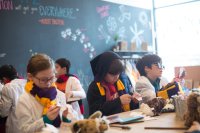Using Pop Culture to Teach STEM
Beach reads and summer blockbusters can be tools to create more engaging STEM lessons for the school year.
Your content has been saved!
Go to My Saved Content.Many adults joke about not being able to do simple math or not being a “science person.” Students hear these perceptions and enter the STEM classroom with negative views. This creates a fixed mindset where students believe that you need to already have certain abilities to be successful in math and science. As educators, we need to create opportunities for students to overcome this mindset.
Connecting classwork to subjects that students are already excited about creates an environment where kids are receptive to learning. They find personal meaning in the lessons, and it gives them an entry point and the confidence they need to become more engaged in a STEM curriculum.
Keep a pulse on what is fun and interesting for kids by reading young adult literature and watching popular shows and movies. Integrating STEM with topics that students are passionate about decreases STEM anxiety and helps students experience how math and science are rooted in creativity and imagination.
Look for Connections
A book or movie doesn’t need to specifically be about STEM, as almost all movies and books are filled with STEM connections that will get kids excited about learning. For example, many students were really excited about the Disney Descendants movies based on the young adult series Isle of the Lost. Disney fairy tale protagonists form a United Kingdom and banish all the villains to an island prison. The story follows the teenage children of the villains as they attend a school to learn to be good.
A STEM connection to the series is not obvious, but we we marked the text with notes every time there was an idea or topic connected to STEM. We filled more than two dozen notes with STEM ideas and references, including these:
- <edu-newsletter></edu-newsletter>
Use the Story
We found that the best way to capture and engage students is by starting with a story. When I taught Mendelian genetics, I connected it to students by asking them to determine why they did or didn’t have detached earlobes. It was a real-world connection that wasn’t that interesting. It was only when rewatching Harry Potter movies that I realized I could connect a lesson in genetics to how Fred and George Weasley breed the magical creatures pygmy puffs.
In the exercise, students learned how specific traits are passed down through generations. The kids loved the lesson so much, they took it a step further to see what happens when their pygmy puff family starts families with other pygmy puff offspring. They even decided to design their own pedigree charts. These connections helped students engage more deeply, take more risks, and move forward with their own inquiry.
Don’t Reinvent, but Layer
Integrating pop culture into STEM education doesn’t mean completely redesigning lessons. Use what you already have, but create this connection to supplement and engage on a deeper level.
For example, I turned a dry anatomy lesson about brain function into a zombie apocalypse choose-your-own-adventure series. Given my own background in neuroscience, I assumed that students would be fascinated to hear how the brain works. After I noticed that my lessons were more about rote memorization and standard test evaluations, I wanted to create a way for students to apply their learning. Because so many of my students were interested in zombies, we created a workshop where students learned the structure and function of different brain regions by examining the various types of zombies that would arise from lesions in specific regions of the brain.
- What part of the brain would be damaged to make this zombie move slowly?
- What part of the brain is damaged to make it angry?
- What part of the brain is damaged to make it hungry?
Beyond the brain explorations, the choose-your-own-adventure scenarios required students to plan a course of action for the various types of zombies they might encounter. We asked these questions:
- What should you do if you meet a zombie with damage to only the amygdala and frontal lobe?
- How should you react if you meet a zombie that only has damage to the cerebellum and hypothalamus?
- If you observe a hungry zombie moving slowly, what type of brain damage have they sustained?
Students were able to go beyond memorization and apply their learning to a scenario. Technology is changing so quickly that it is not enough to just know the science—students need to be able to innovate and apply ideas creatively. Connecting to pop culture helps students see things creatively, form deeper connections, and think out of the box.
